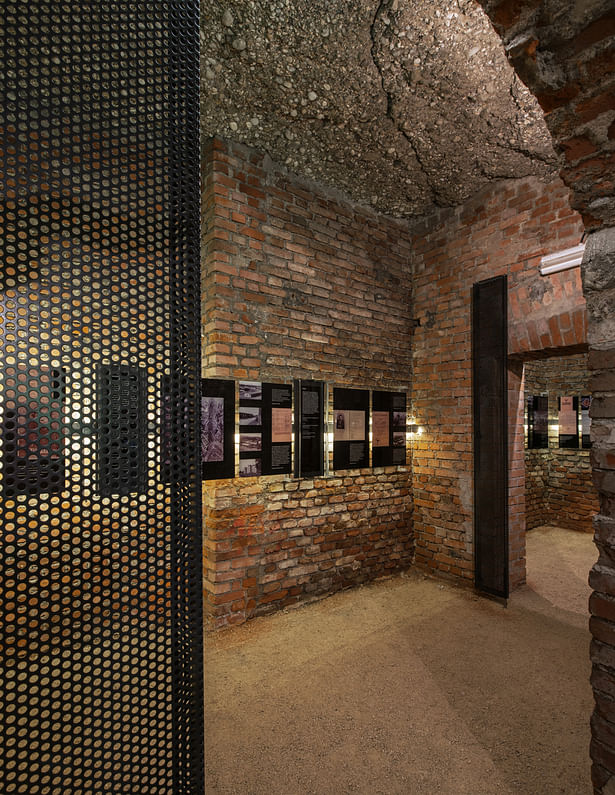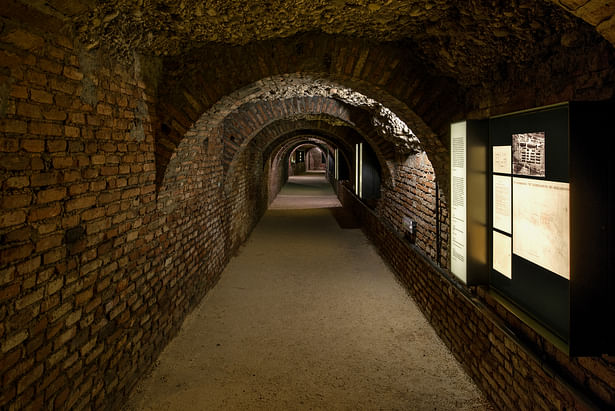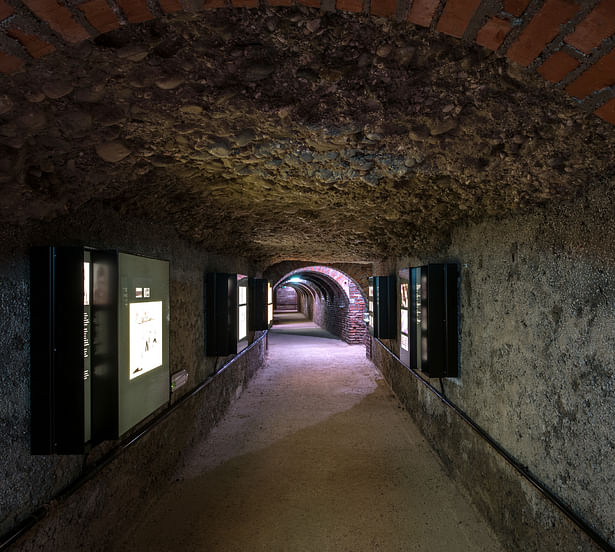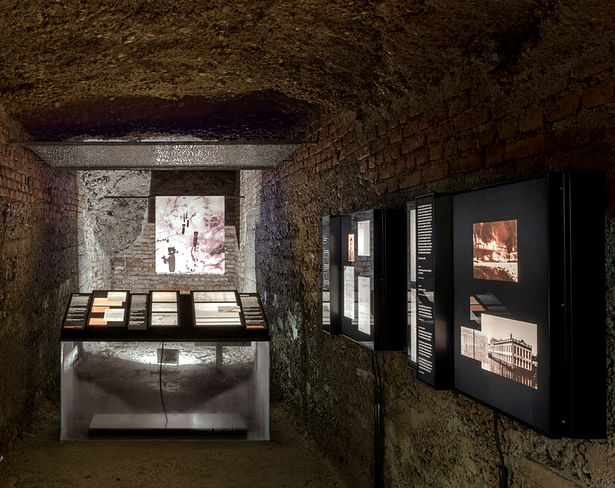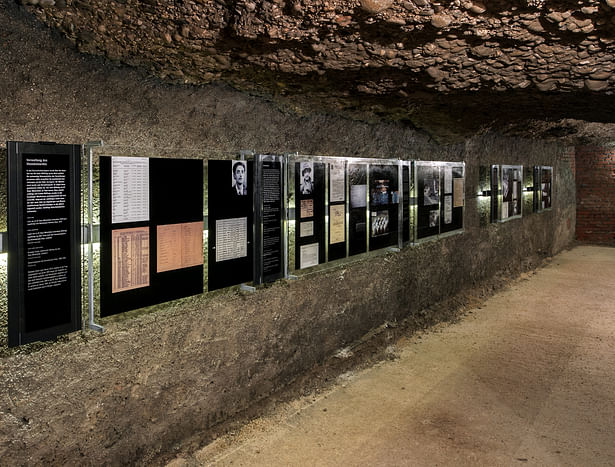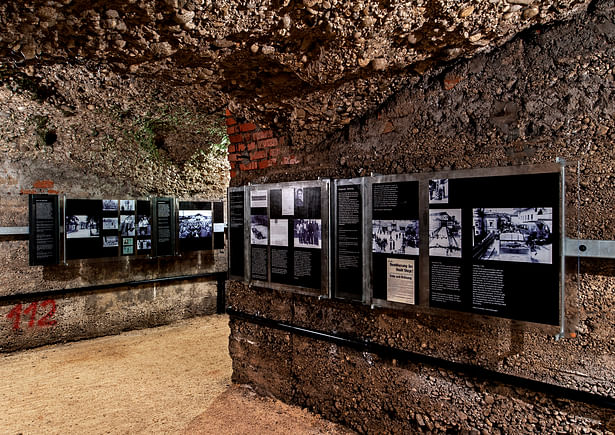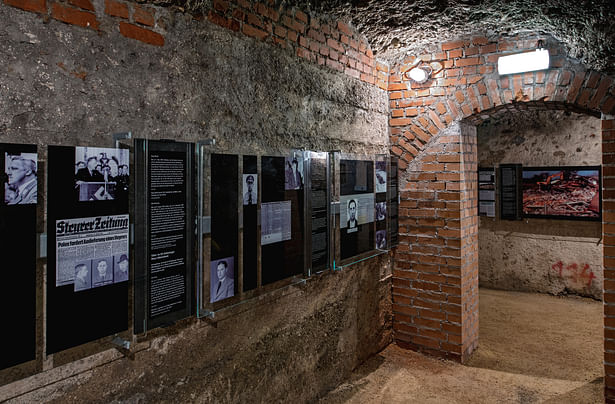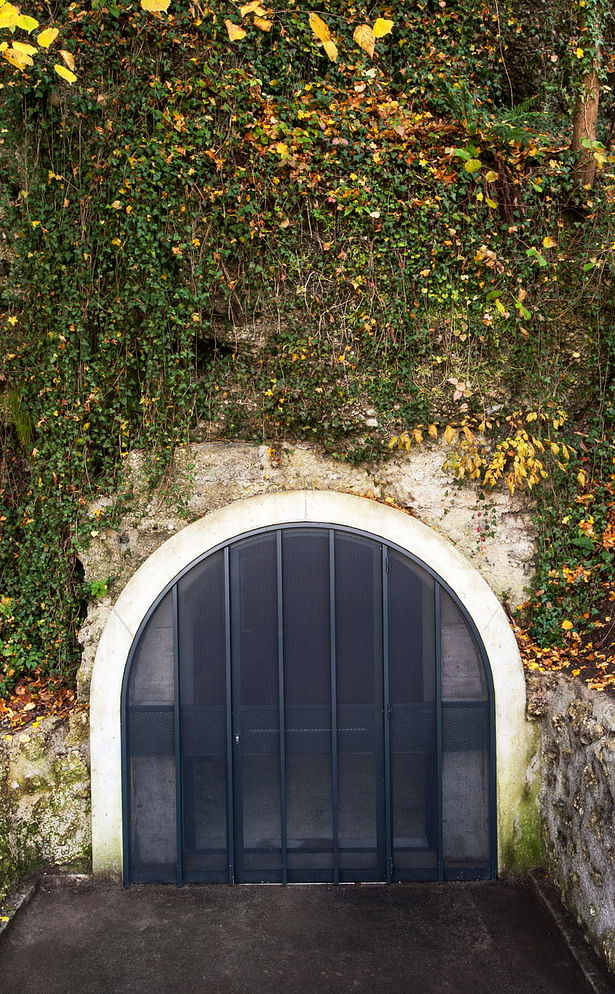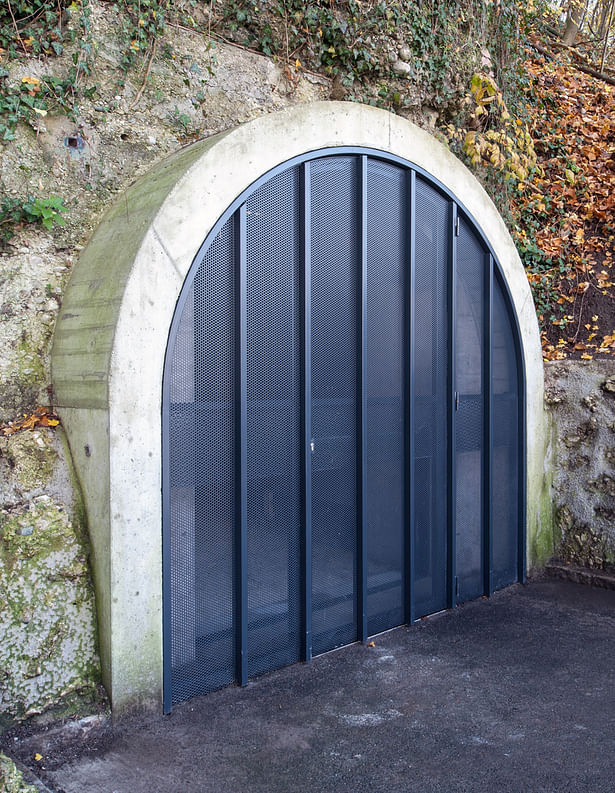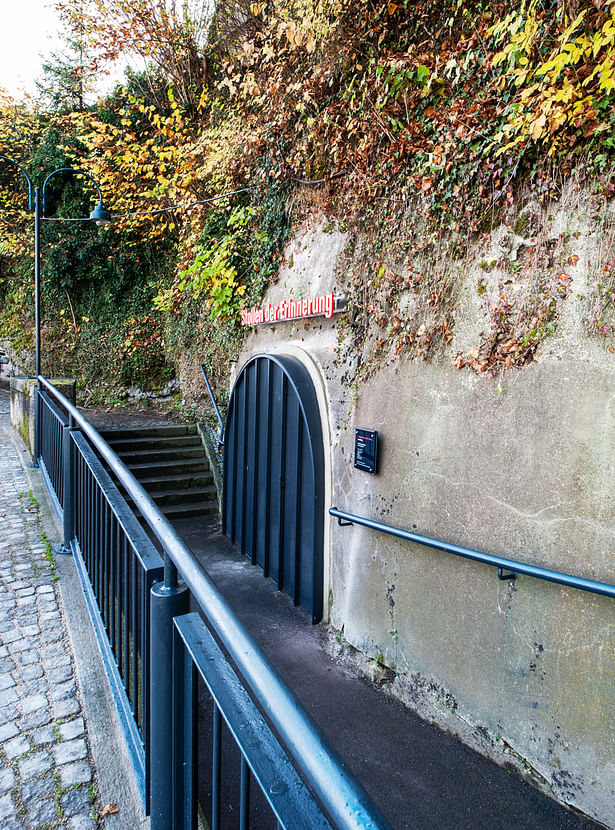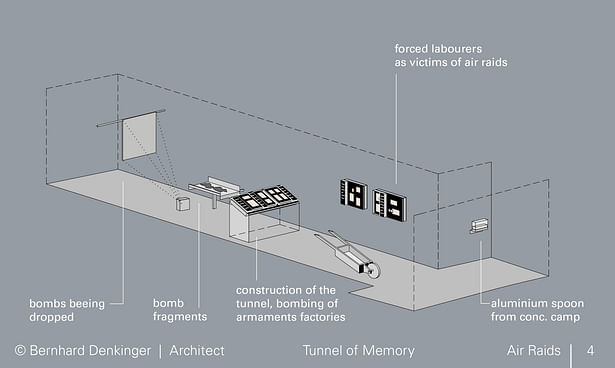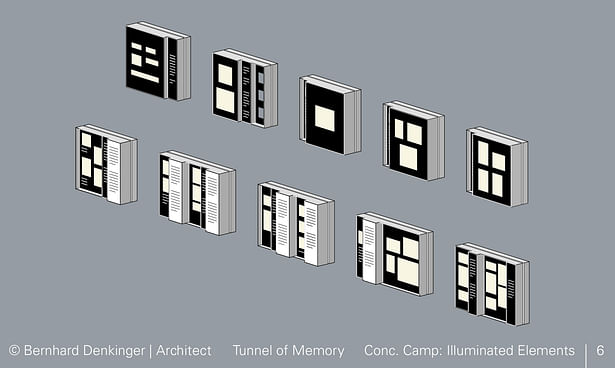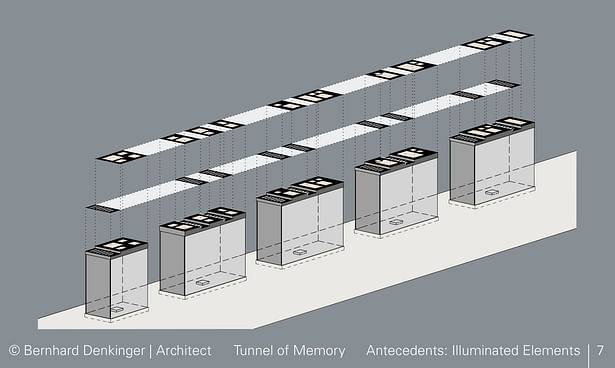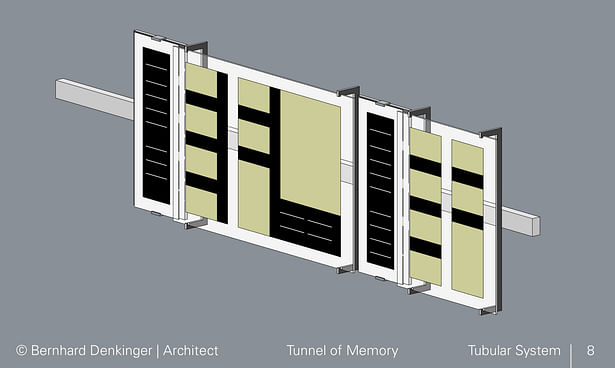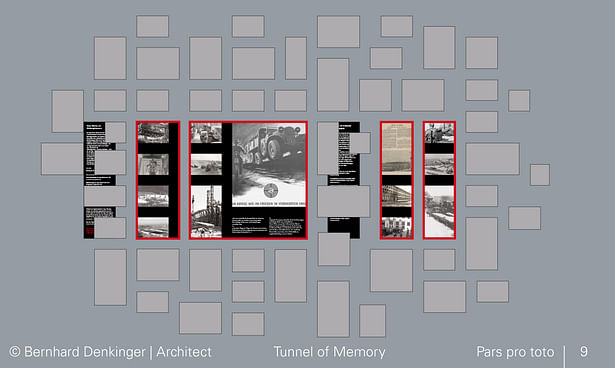
Vienna, AT
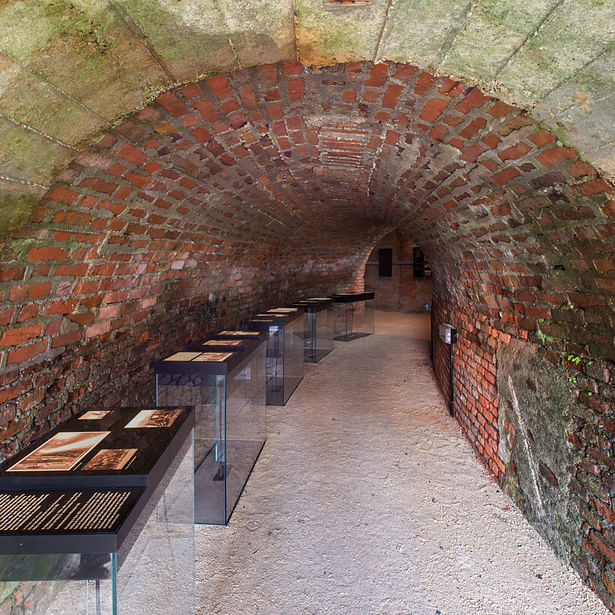
Summary:
The 140 m U-shaped underground tunnel system was built from 1943 onwards by inmates of Steyr-Muenichholz concentration camp. The centre of the building is marked by a series of twelve light installations explaining the construction of the former Steyr-Muenichholz concentration camp and the living conditions there. A sequence of five “flashlights”, horizontal surfaces with backlit documents leads deep into the tunnel system.
Steel perforated metal portals framed in new exposed concrete surrounds make the tunnel profile visible from outside.
The tunnel is seen as a dark cave-like space. The light brought in from the outside "peels" zones out of the darkness, in which the exhibition is presented.
The three-dimensional design of the illuminated elements with set-back parts and recessed niches permits a “layered” perception. When approaching the stations the impression is given of a wealth of pictures and documents or a series of texts that appear to stand out from the other exhibition documentation.
Tunnel of Memory - Architectural structure and concept
The tunnel system
The 140 m U-shaped underground tunnel system was built from 1943 onwards by inmates of Steyr-Münichholz concentration camp. It is close to the town centre of Steyr on a busy foot and cycling path. The tunnel was intended to shelter the civilian population during air raids. Unlike other Second World War underground bunkers the tunnel profile is very narrow and low and not lined with concrete arches and walls. The stone walls are covered with rough plaster or thin brick facing. In some areas the load-bearing capacity of the unfinished stone ceiling is increased by means of brick belts or arches. The inner shelter was separated from the entrance areas (gates 1 and 2) by airlocks. In the middle of the tunnel system are two side tunnels.
The tunnel as a monument
The tunnel is a ‘primitive’ structure. It is regarded as a monument because of its history. The system was built with the simplest means and tools. The traces of the stone working can be clearly seen on the walls and ceilings, but archaic elementary-looking rooms were also created in these makeshift, improvised and meagre circumstances.
The exhibition architecture attempts through the creation of defined spaces – through breaks, empty areas and interruptions to the flow – to create “windows of perception” for the particular spatial and sensory qualities of the underground structure. It divides the tunnel system into contrasting sequences: rhythmically structured paths suggesting movement, more static and contemplative sections, and short “meditative” passages that invite the visitor to stop and think.
The tunnel is seen as a dark cave-like space. The light brought in from the outside ‘peels’ zones out of the darkness, in which the exhibition is presented. The light intensity varies during the visit. The subdued diffuse light of the ‘empty stretches’, which is just bright enough for the route to be seen, becomes more intense in the stations. Inside the tunnel system the light withdraws into the exhibition installations, turning them into illuminated islands standing out against the darkness.
The former airlocks and the two side tunnels, two “dead ends”, are sections in their own right dedicated to particular themes. Steel perforated metal portals framed in new exposed concrete surrounds make the tunnel profile visible from outside. A light, fine-grained floor covering is used throughout the system.
The stations
The Antecedents and Approach to History After 1945 stations are at the beginning and end, respectively, of the exhibition between the entrance and exit gates and the airlocks. In the front airlock is the Forced Labour station; in the back airlock is History of the Perpetrators. The core themes Steyr-Münichholz Concentration Camp, Air Raids, Incineration of Inmates’ Bodies in Steyr Crematorium and Death Marches of Hungarian Jews, covering the time from the establishment of the concentration camp until liberation in 1945, form a connected inner tour in the former shelter area. Side tunnel A in the middle of the system deals with the building of the Steyr bunker system and the bombing of the Steyr industry and armaments factories.
The exhibition visit
Antecedents
The narration of the historical situation in the 1930s is presented in five closely linked blocks in the entrance area, gradually leading visitors into the interior of the tunnel system. The destination of this rhythmic movement is a picture wall with Nazi propaganda posters and works pictures illustrating the enormous expansion of the Steyr works after its integration in the German Reich armaments industry.
Forced Labour
Semi-transparent perforated sheet metal elements mark the border to the first air-lock. Behind this “curtain”, standing out from the series of pictures, the portrait of a forced labourer and an aerial photo of Steyr introduce visitors to the Forced Labour station. The aerial photo taken in March 1945 shows the extent of the civilian and forced labour camps and the relatively small concentration camp. Reduced to a few “constants”, typical aspects of the accommodation and camp, work situation, inadequate nutrition and hunger, and inmate hierarchies are shown in the form of short picture series supplemented by the recollections of former forced labourers.
Steyr-Münichholz Concentration Camp
The labyrinthine airlock area marked by several changes of direction leads to one of the core themes of the exhibition, Steyr-Münichholz Concentration Camp. In a long gently rising corridor subdivided by means of brick belts, documents on the erection of the camp and the living conditions of the inmates are shown in ten illuminated installations. The first visual impression is formed by recollections of former inmates. Presented as a series of white backlit text surfaces, they stand out clearly from the corresponding Nazi administration documents in set-back niches. At the back of this station are drawings by former inmates instead of texts. Some of these drawings were completed in the concentration camp. This artistic interpretation of the experiences offers a change of perspective. Whereas the recollections relentlessly describe the suffering, the interpretation of the experience in drawings or illustrations are symbolic of a remnant of individuality.
Air Raids
In the Air Raids station, which is accessed from the middle of the Steyr-Münichholz Concentration Camp station, four representation lines merge. Various aspects of the air raids shown in individual pictures – a dramaturgy that gradually intensifies – come together to produce an overall impression.
Two original objects, a cart that appears to emerge from side tunnel A and an aluminium spoon from Steyr-Münichholz concentration camp, mark the entrance. On the right-hand wall two illuminated installations show the forced labourers as victims of air raids and Nazi “disciplinary measures”. The two illuminated showcases lead to a glass barrier, a desk with objects on the construction of the tunnel and the bombing of the Steyr armaments factories. From this perspective, bomb fragments can be seen further back. The sight of the bomb fragments connects with the cart shown at the entrance, as inmates had to carry off the rubble caused by the bombs in such carts.
The culminating visual highpoint of the sequence is a brightly lit aerial photo at the end of the side tunnel showing bombs being dropped on Steyr in April 1944.
The division of the side tunnel into accessible and inaccessible areas also reflects the regulated and exclusive access to the air raid shelters. In spite of objections by the civilian population, towards the end of the war separate parts of the air raid shelters were opened to concentration camp inmates so as to preserve this last labour reserve for the Nazi regime.
Death Road
At the back intersection, between the two halves of the tunnel, are the stations Incineration of Inmate Corpses from Mauthausen concentration camp in the Steyr crematorium, Discovery of Urn Graves in the local cemetery and two Death Marches by Hungarian Jews to Steyr and through surrounding villages. The emphasis here is on the reconstruction of the events, presentation of evidence and commemoration of the victims. In place of recollections by victims are accounts by eyewitnesses and those involved from the local population.
Guided by the research and archaeological findings, these stations are combined into a Death road. It leads from the first lists in 1946 to the registration of the concentration camp corpses incinerated in Steyr crematorium and Opening of the Urn Graves in 2011 to the two historical Death Marches of Hungarian Jews in April 1945. The road ends in an empty space. The following station, Liberation, cannot be seen, as most of the inmates and forced labourers obliged to take part in the death marches did not survive to experience this liberation.
Liberated and Back in the Camp
After the first empty space, a picture protruding into the access area showing columns of American army vehicles arriving in Steyr in May 1945 leads to the stations Liberation and Displaced Persons. In the Liberation station visitors have a sight axis towards an empty road in the Steyr DP camp. Monotonous and lost-looking portrait photos show Jewish youths waiting to emigrate to Palestine. The end of the waiting and the departure at the end of the Displaced Persons stations cannot be seen and only become visible on approaching the station. A large photo taken in 1945 showing a crowd in front of Salzburg railway station stands for the huge number of people who left to seek a new existence – in many cases after years spent in former concentration and forced labour camps.
Perpetrator Room
In the exit double-door system, perpetrators, including one woman, from Steyr are shown. When entering the room, along with very minimalistic representations of the individual “perpetrator profiles”, a blow-up colour photo is visible outside the room. It shows the demolition of the last surviving barrack of the former Steyr-Münichholz concentration camp in 1993. The exit from the room is narrowed by means of solid stone pillars under the load-bearing brick belt. These redundant “supports” built in place of the former 25 cm partition wall emphasise the impression of heaviness and oppression created by the stone ceiling, which descends to eye-level in the small airlock space. From the inside of the room and in view of the confrontation with the history of the perpetrators, the demolition picture symbolises the inconsiderate and unthinking approach for many years to the particular history of the place and its traces.
Approach to History after 1945
The last exhibition space between the former airlock and gate 2 is about Commemoration and Memory, how the history of the victims can be kept alive and passed on. The tunnel descends steeply at this point. The path is divided into long horizontal sections, and the difference in height between the stations is emphasised. This downward rhythm is used for a “procession of stones”. Starting with a photo showing a memorial event organised by the Mauthausen Committee Steyr (“Requiem 05”), candle holders made from granite blocks used during this event lead to a group picture of former inmates. Two further small stations show pictures of Communist resistance fighters, a woman resistance fighter and a Catholic priest from Steyr interned in Dachau concentration camp.
Perception and presentation
The presentation is based on two simple systems, modified to give different emphasis.
The entrance area and centre of the exhibition are highlighted by means of illuminated elements. A tubular system with attached glass and sheet steel surfaces connects the illuminated stations and structures the second half of the exhibition tour at the back.
The three-dimensional design of the illuminated elements with set-back parts and recessed niches permits a “layered” perception with various levels containing the very diverse and concentrated pictures and documents, accounts and commentaries. When approaching the stations the impression is given of a wealth of pictures and documents or a series of texts that appear to stand out from the other exhibition documentation.
The tubular system also allows the more attractive photos and documents to be arranged in front of the exhibition commentaries. The exhibits are seen as small visible representatives of a large number of potential non-exhibited documents, objects that cannot be shown because they no longer exist, have been lost or destroyed or could not be included in the exhibition selection. Positioned at the edges of black background surfaces, the documents appear to be cut out from an “endless” fabric – a large number of similar objects. Between these object areas are narrow vertical text strips. They interrupt the perception of the object areas as a continuous and coherent layer, emphasising their isolated and seperate nature.
Status: Built
Location: Steyr, AT
Firm Role: Architecture, Exhibition Design, Graphic Design, Planning and Construction Management
Additional Credits: Idea: Karl Ramsmaier, Mauthausen Komitee Steyr (MHKS)
Content: Bertrand Perz (curator, concept consultant), Regina Wonisch (curator), Karl Ramsmaier (MHKS), Waltraud Neuhauser (MHKS) and team Mauthausen Komitee Steyr
Client: Verein Mauthausen Komitee Steyr
All photograps by: Andreas Buchberger
